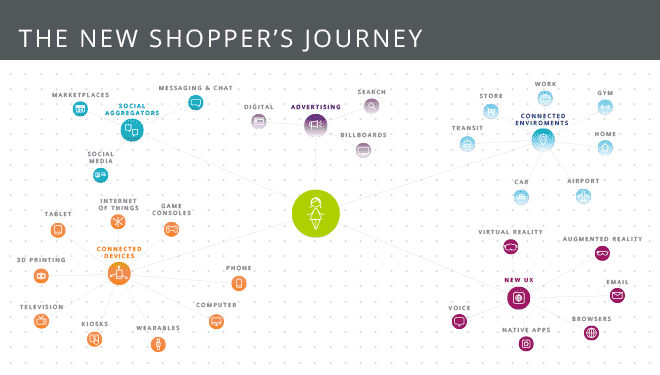A recent article on the website Business of Fashion summed up a fundamental shift in retail, noting that, “ten years ago, you needed a major department store to be successful. Now, you need Instagram.”
Indeed, Instagram has become an important conduit for retailers to connect with customers – but it is just one of an increasing number of touchpoints in the new “shopper journey.” This democratization of retail means that consumers discover products and make a purchase from any internet-connected thing and have a shopping experience where each channel (including stores) blends seamlessly into the other.
While each shopping journey is unique, the one constant is that the consumer is at the center of it all as they have more access, control, and influence than ever before. Not to put too fine a point on it, the customer is the sun around which the planets (retailers) have no choice but to revolve.
Today’s consumers, particularly millennials with $2.5 trillion in global spending power, expect all touchpoints to enable commerce instantly. That means social media, messaging apps and online marketplaces today – and smart home appliances, dressing room mirrors, virtual reality and digital assistance tomorrow – must remove the friction between inspiration and transaction.
Retailers must shift from a model that pulls consumers to their brand to one that pushes their brand to consumers. The challenge is that retailers’ technology is hardcoded to solve a specific problem by specific channel. Making it nearly difficult, if not impossible, to move at the speed of consumers.
Social media (i.e. Pinterest) and messaging platforms (i.e. WeChat) represents a small but fast-growing percentage of online spending. Consumers are empowered to receive recommendations from trusted friends and family, and immediately purchase within the context of these platforms without having to leave and visit the merchant’s site.
This is a huge opportunity for retailers, but where to begin?
First, walk before you run. If a retailer has decided to sell products in a democratized and distributed manner but is not already marketing itself successfully on these social media channels, it’s time to step back and build an audience before enabling transactions.
However, if you’ve already got a large and loyal following, you’re halfway there. For brands whose customers live on social media, as a prime example, it’s perhaps the single most important marketing vehicle, one where retailers have a great opportunity to shorten the gap between engagement and conversion.
Consider Gardener’s Supply, a Vermont-based gardening destination. The company was already actively engaged with its 50,000 Pinterest followers and so in 2015 it implemented Pinterest Buyable Pins.
The company told clickz.com in May that the Buyable Pins have been its most transformative revenue factor on social media.
Here’s the thing about the new shopping journey: it can start and end anywhere. Your shopper may “showroom” an item in your store and buy it online later; discover an item via a Facebook ad and navigate to your site to purchase; research online before buying in your store; save an item in their shopping cart on their phone and buy later on their computer.
The possibilities, no doubt, create challenges for retailers as they try to fully understand and engage with consumers on every step of the journey. It’s understandable that retailers fret about their ability to keep up with consumer expectations throughout this circular and complex journey.
This is where a unified commerce platform could add agility by removing the traditional complexity of disparate front-end systems. Since you can’t know what the next “big thing” will be, or what steps will pop up in tomorrow’s shopper journey, retailers need to be able to take advantage of opportunities as they arise.
Leading retailers will want to be wherever their customers display an intention to purchase. And consumers expect consistent experience across every channel of engagement – including flawless fulfillment, returns and service. The key enabler is an agile and scalable commerce platform that empowers retailers to quickly and easily light up and extend their brand, and enable transactions, across each channel as they emerge.
As big as digital commerce is today, it still represents less than 8 percent of all U.S. retail, meaning that there is enormous upside for retailers to efficiently extend commerce to touchpoints we can’t even fathom today.
Rob Garf is Vice President of Industry Strategy and Insights for Salesforce Commerce Cloud
